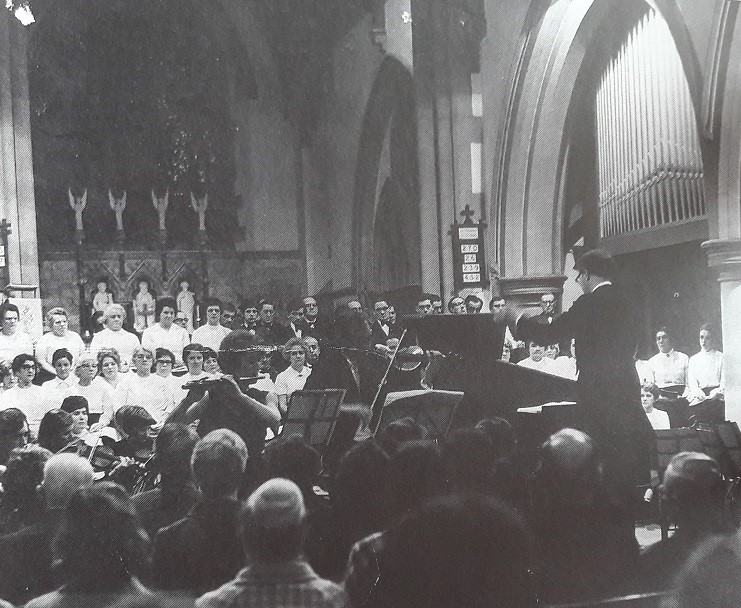Details about the architects of the church added by Jacqueline Banerjee. Recent photographs by the author, and the earlier ones, by kind permission, from the archives of W. Clarke Ltd, Llandaff, and St Martin's. See captions. You may use these images without prior permission for any scholarly or educational purpose as long as you (1) credit the photographer or source, and (2) link your document to this URL in a web document or to the Victorian Web in a print document. [Click on all the images to enlarge them.]

St Martin's church, Caerphilly, has rather a complicated building history, involving several Victorian architects. It was originally designed by the Gothic Revivalist Charles Buckeridge (c.1832-1873), an architect who had been proposed for RIBA associateship in 1861 by Benjamin Ferrey, George Gilbert Scott and G. E. Street. Unfortunately, Buckeridge died before work could commence. J. L. Pearson eventually built the church between 1877 and 1879. It was extended later by G E Halliday (1857-1922): the nave was lengthened by two bays in 1904-5 and the tower was constructed in 1907-10. By then, Halliday was in partnership with J. W. Rodger (1859-1950). Note that the church was further extended in 1938 when the south isle was widened. The construction materials are "snecked rock-faced grey-green sandstone with Bathstone dressings, under red tiled roofs" ("Church of St Martin").


Left: Reredos. Right: Design drawing for the reredos.
Halliday's work in the interior was particularly fine. In 1902 he designed a reredos for the church comprising a central figure of Christ with the figures of St Martin on the left and St Thomas on the right under gabled arches of carved Penarth alabaster, together with statues of four angels standing on raised pedestals of elaborately carved Penarth alabaster above. Either side of the reredos are wings of polished Penarth alabaster tiles.


Photographs from W. Clarke and Co.'s archive. Left: Figures of Christ with St Martin and St Thomas either side. Right: Figures of the four angels.
Production of the reredos was undertaken by the firm of W. Clarke of Llandaff with employee Harry Gregory being responsible for most of the detailed carving of the figures. The project cost £254. Halliday's design drawing and photographs of the figures of Christ with the two saints and of the four angels have survived in Clarke's archives. The angels and their pedestals which were still present in the 1960s have since been removed. The fate of the angels is unknown but the pedestals have survived at the church.


Left: The intricately carved pedestals. Right: Reredos intact, with angels on their pedestals in the background, in this photograph of St Martin's in the 1960s, from the church archives.
In 1909 Halliday designed a pulpit for the church which was also made by W. Clarke of Llandaff. Beneath the main carved timber body of the pulpit is a band of Penarth alabaster carved with oak leaves, the whole is supported on a tapered pedestal carved from red sandstone quarried at St Bees in Cumbria.


Left: The pulpit. Right: Close-up of carved Penarth alabaster in the pulpit.
The exquisite stone-carving and rich materials of the church can still be glimpsed in the workmanship of Halliday's pulpit. The project cost for this item alone was £90.
Bibliography
"Charles Buckeridge." Dictionary of Scottish Architects. Web. 23 July 2023.
"Church of St Martin." British Listed Buildings. Web. 23 July 2023.
Clarke, W. Caerphilly reredos. Bill Book 6: 326. Web. 23 July 2023.
Clarke, W. Caerphilly reredos. Day Book 7: 425-28.
Clarke, W. Caerphilly pulpit. Bill Book 8: 169.
Clarke, W. Caerphilly pulpit. Day Book 10: 341-2.
"John W. Rodger (1859-1950) 41st President." Cardiff Naturalists' Society / Cymdeithas NaturiaethwyrCaerdydd. Web. 23 July 2023.
Newman, John, with contributions from Stephen Hughes and Anthony Ward. The Buildings of Wales: Glamorgan (Mid-Glamorgan, South Glamorgan and West Glamorgan). London: Penguin/University of Wales Press, 1995.
Statham, Michael. Penarth Alabaster. Welsh Stone Forum, 2017.
Created 23 July 2023